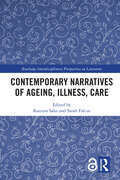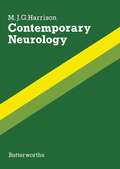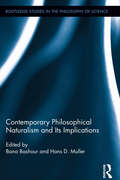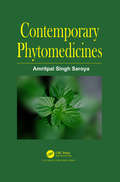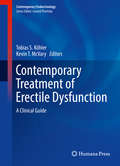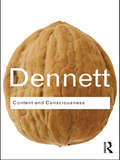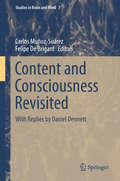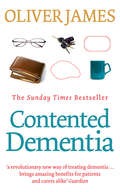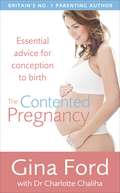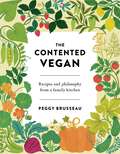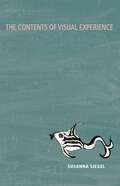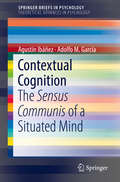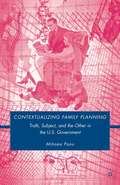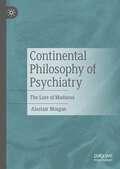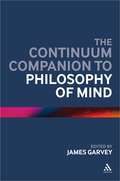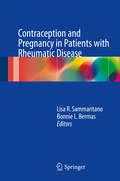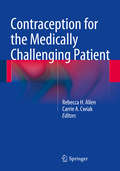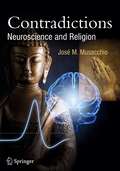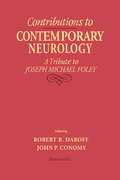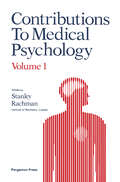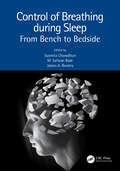- Table View
- List View
Contemporary Narratives of Ageing, Illness, Care (Routledge Interdisciplinary Perspectives on Literature)
by Katsura Sako Sarah FalcusThis collection of essays explores cultural narratives of care in the contexts of ageing and illness. It includes both text-based and practice-based contributions by leading and emerging scholars in humanistic studies of ageing. They consider care not only in film (feature and documentary) and literature (novel, short story, children’s picturebook) but also in the fields of theatre performance, photography and music. The collection has a broad geographical scope with case studies and primary texts from Europe and North America but also from Hong Kong, Japan, Australia, Argentina and Mexico. The volume asks what care, autonomy and dependence may mean and how these may be inflected by social and cultural specificities. Ultimately, it invites us to reflect on our relations to others as we face the global and local challenges of both the pandemic and ageing societies.
Contemporary Narratives of Ageing, Illness, Care (Routledge Interdisciplinary Perspectives on Literature)
by Katsura Sako Sarah FalcusThis collection of essays explores cultural narratives of care in the contexts of ageing and illness. It includes both text-based and practice-based contributions by leading and emerging scholars in humanistic studies of ageing. They consider care not only in film (feature and documentary) and literature (novel, short story, children’s picturebook) but also in the fields of theatre performance, photography and music. The collection has a broad geographical scope with case studies and primary texts from Europe and North America but also from Hong Kong, Japan, Australia, Argentina and Mexico. The volume asks what care, autonomy and dependence may mean and how these may be inflected by social and cultural specificities. Ultimately, it invites us to reflect on our relations to others as we face the global and local challenges of both the pandemic and ageing societies.
Contemporary Neurology
by M. J. G. HarrisonContemporary Neurology compiles a large series of papers on the commonest neurological problems. This book discusses the management of epilepsy, involuntary movements, nerve and muscle diseases, and multiple sclerosis. The areas on infections, cerebrovascular disease, trauma, intracranial pressure, and vertebral column are also elaborated. This text likewise describes medical procedures on how to do a lumbar and cisternal puncture. Other topics include headache in children, hyperventilation, dizziness, funny turns—neurological, dysarthria, facial pain, and nystagmus. The weakness of the legs, loss of memory, coma, brain death, complications of alcoholism, and stupor and akinetic mutism are also covered. This publication is valuable to clinicians and examination candidates preparing for the DPM, MRCP (UK) and Neurology/Psychiatry “Boards".
Contemporary Philosophical Naturalism and Its Implications (Routledge Studies in the Philosophy of Science)
by Bana Bashour Hans D. MullerOne of the most pervasive and persistent questions in philosophy is the relationship between the natural sciences and traditional philosophical categories such as metaphysics, epistemology and the mind. Contemporary Philosophical Naturalism and Its Implications is a unique and valuable contribution to the literature on this issue. It brings together a remarkable collection of highly regarded experts in the field along with some young theorists providing a fresh perspective. This book is noteworthy for bringing together committed philosophical naturalists (with one notable and provocative exception), thus diverging from the growing trend towards anti-naturalism. The book consists of four sections: the first deals with the metaphysical implications of naturalism, in which two contributors present radically different perspectives. The second attempts to reconcile reasons and forward-looking goals with blind Darwinian natural selection. The third tackles various problems in epistemology, ranging from meaning to natural kinds to concept learning. The final section includes three papers each addressing a specific feature of the human mind: its uniqueness, its representational capacity, and its morality. In this way the book explores the important implications of the post-Darwinian scientific world-view.
Contemporary Philosophical Naturalism and Its Implications (Routledge Studies in the Philosophy of Science)
by Bana Bashour Hans D. MullerOne of the most pervasive and persistent questions in philosophy is the relationship between the natural sciences and traditional philosophical categories such as metaphysics, epistemology and the mind. Contemporary Philosophical Naturalism and Its Implications is a unique and valuable contribution to the literature on this issue. It brings together a remarkable collection of highly regarded experts in the field along with some young theorists providing a fresh perspective. This book is noteworthy for bringing together committed philosophical naturalists (with one notable and provocative exception), thus diverging from the growing trend towards anti-naturalism. The book consists of four sections: the first deals with the metaphysical implications of naturalism, in which two contributors present radically different perspectives. The second attempts to reconcile reasons and forward-looking goals with blind Darwinian natural selection. The third tackles various problems in epistemology, ranging from meaning to natural kinds to concept learning. The final section includes three papers each addressing a specific feature of the human mind: its uniqueness, its representational capacity, and its morality. In this way the book explores the important implications of the post-Darwinian scientific world-view.
Contemporary Phytomedicines
by Amritpal Singh SaroyaThe term phytomedicine was coined by French physician Henri Leclerc in 1913. Till recently phytomedicine has remained in the background. But due to emerging challenges to the conventional pharmaceutical industry (cost effectiveness and potency of the drugs), phytomedicine has made a dramatic comeback. Phytomedicine has witnessed several changes and several new concepts have been introduced. Phytomedicine, although, a separate discipline, is strongly linked to Phytotherapy and Phytopharmacology. As the title suggests the book is an attempt to bridge the gap between fundamental and emerging concepts in this field of medicine. The book has been divided into two parts. Part A deals with core issues of the phyto-pharmaceutical drug industry. The book begins with an introductory chapter dealing with basic definitions with phytomedicine. Chapters 2-5 narrate emerging subjects such as Phytopharmacovigilance, Phytopharmacoeconomics, Phytopharmacoepidemiology and Phytopharmacogenomics. Chapter 6 discusses ethical issues in phytomedicine. Chapter 7 covers recent advances in drug delivery systems in phytomedicine whereas Chapter 8 is about application of nanotechnology in the field of phytomedicine. The further chapters cover metabolomics, regulatory and legal aspects of the phyto-pharmaceutical drug industry. The chapter on herbal bioavailability enhancing agents is the salient feature of Part-A. Part B is related to applied research in the field of phytomedicine. Experimental findings on phyto-bioactive agents such as withanolides, steroidal alkaloids, phytosteroids and phytocannabinoids have been elaborated. Nine annexures related to herbal drug registration are included.
Contemporary Phytomedicines
by Amritpal Singh SaroyaThe term phytomedicine was coined by French physician Henri Leclerc in 1913. Till recently phytomedicine has remained in the background. But due to emerging challenges to the conventional pharmaceutical industry (cost effectiveness and potency of the drugs), phytomedicine has made a dramatic comeback. Phytomedicine has witnessed several changes and several new concepts have been introduced. Phytomedicine, although, a separate discipline, is strongly linked to Phytotherapy and Phytopharmacology. As the title suggests the book is an attempt to bridge the gap between fundamental and emerging concepts in this field of medicine. The book has been divided into two parts. Part A deals with core issues of the phyto-pharmaceutical drug industry. The book begins with an introductory chapter dealing with basic definitions with phytomedicine. Chapters 2-5 narrate emerging subjects such as Phytopharmacovigilance, Phytopharmacoeconomics, Phytopharmacoepidemiology and Phytopharmacogenomics. Chapter 6 discusses ethical issues in phytomedicine. Chapter 7 covers recent advances in drug delivery systems in phytomedicine whereas Chapter 8 is about application of nanotechnology in the field of phytomedicine. The further chapters cover metabolomics, regulatory and legal aspects of the phyto-pharmaceutical drug industry. The chapter on herbal bioavailability enhancing agents is the salient feature of Part-A. Part B is related to applied research in the field of phytomedicine. Experimental findings on phyto-bioactive agents such as withanolides, steroidal alkaloids, phytosteroids and phytocannabinoids have been elaborated. Nine annexures related to herbal drug registration are included.
Contemporary Treatment of Erectile Dysfunction: A Clinical Guide (Contemporary Endocrinology)
by Tobias S. Köhler Kevin T. McVaryNow in a revised and expanded second edition, this comprehensive clinical guide remains a state-of-the-art synthesis of the literature, covering all aspects of treating erectile dysfunction (ED) and other related male sexual dysfunctions. Cardiovascular, hormonal, psychological and lifestyle factors are each considered in diagnosis and treatment, which includes pharmacological, surgical and prosthetic management strategies. The effects of prostate cancer and its treatment are also discussed, as are Peyronie’s disease, priapism and ejaculatory disorders. New chapters in this edition discuss the profound effects of lifestyle change on sexual function, alternative and internet drugs that affect sexual function, endovascular approaches to ED, penile length considerations, the effect of radiation on erectile function, and optimizing ED research. Presenting a better understanding of what causes erectile dysfunction and the effective medications and non-medication treatments used to treat the condition, this invaluable title offers all physicians, residents, and fellows – and even medical students and other health professionals such as nurse practitioners and physician assistants – an essential reference for enhancing diagnosis and treatment of this common and debilitating disorder.
Content and Consciousness
by Daniel C. DennettContent and Consciousness is an original and ground-breaking attempt to elucidate a problem integral to the history of Western philosophical thought: the relationship of the mind and body. In this formative work, Dennett sought to develop a theory of the human mind and consciousness based on new and challenging advances in the field that came to be known as cognitive science. This important and illuminating work is widely-regarded as the book from which all of Dennett’s future ideas developed. It is his first explosive rebuttal of Cartesian dualism and one of the founding texts of philosophy of mind.
Content and Consciousness
by Daniel C. DennettContent and Consciousness is an original and ground-breaking attempt to elucidate a problem integral to the history of Western philosophical thought: the relationship of the mind and body. In this formative work, Dennett sought to develop a theory of the human mind and consciousness based on new and challenging advances in the field that came to be known as cognitive science. This important and illuminating work is widely-regarded as the book from which all of Dennett’s future ideas developed. It is his first explosive rebuttal of Cartesian dualism and one of the founding texts of philosophy of mind.
Content and Consciousness Revisited: With Replies by Daniel Dennett (Studies in Brain and Mind #7)
by Carlos Muñoz-Suárez Felipe De BrigardWhat are the grounds for the distinction between the mental and the physical? What is it the relation between ascribing mental states to an organism and understanding its behavior? Are animals and complex systems vehicles of inner evolutionary environments? Is there a difference between personal and sub-personal level processes in the brain? Answers to these and other questions were developed in Daniel Dennett’s first book, Content and Consciousness (1969), where he sketched a unified theoretical framework for views that are now considered foundational in cognitive science and philosophy of mind.Content and Consciousness Revisited is devoted to reconsider the ideas and ideals introduced in Dennett’s seminal book, by covering its fundamental concepts, hypotheses and approaches and taking into account the findings and progress which have taken place during more than four decades. This book includes original and critical contributions about the relations between science and philosophy, the personal/sub-personal level distinction, intelligence, learning, intentionality, rationality, propositional attitudes, among other issues of scientific and philosophical interest. Each chapter embraces an updated approach to several disciplines, like cognitive science, cognitive psychology, philosophy of mind and cognitive psychiatry.
Contented Dementia: 24-hour Wraparound Care for Lifelong Well-being
by Oliver JamesDementia is a little understood and currently incurable illness, but much can be done to maximise the quality of life for people with the condition. Contented Dementia - by clinical psychologist and bestselling author Oliver James - outlines a groundbreaking and practical method for managing dementia that will allow both sufferer and carer to maintain the highest possible quality of life, throughout every stage of the illness.A person with dementia will experience random and increasingly frequent memory blanks relating to recent events. Feelings, however, remain intact, as do memories of past events and both can be used in a special way to substitute for more recent information that has been lost. The SPECAL method (Specialized Early Care for Alzheimer's) outlined in this book works by creating links between past memories and the routine activities of daily life in the present. Drawing on real-life examples and user-friendly tried-and-tested methods, Contented Dementia provides essential information and guidance for carers, relatives and professionals.
The Contented Pregnancy
by Gina Ford Dr Charlotte ChalihaDiscovering that you are about to become a mum is one of life's most joyful moments. This indispensable guide from Gina Ford and consultant obstetrician Dr Charlotte Chaliha provides mums-to-be with the practical, reassuring and down-to-earth advice they need for a calm and contented pregnancy. Includes:- a month by month guide to the growth of your baby and your changing body- up-to-date guidance on nutrition, exercise and health- advice on preparing your home and lifestyle for a new arrival- how to prepare yourself for labour and birth- what to expect in the first few weeks with your babyThe Contented Pregnancy is the essential guide to enjoying a relaxed pregnancy and giving your baby the very best start in life.
The Contented Vegan: Recipes and Philosophy from a Family Kitchen
by Peggy Brusseau'The Contented Vegan is more than a cookbook. This is a practical guide to positive change to benefit future generations – and you'll truly enjoy the tasty dishes' Jane Goodall PhD, DBEHow to lead a happy, healthy vegan lifestyleThe Contented Vegan is your essential guide to transitioning to a vegan lifestyle, combining delicious recipes with practical, inspirational and reassuring advice on making the switch.Food writer Peggy Brusseau has been a vegan for over thirty years, and is often asked for guidance by people considering changing their diet. How do I get enough protein? How can I eat a plant-based diet when my partner doesn't want to? Is it safe for kids?In this book she answers all these questions and more, as well as providing over 100 simple, tasty recipes to inspire you in the kitchen, from breakfasts and snacks, through to easy midweek suppers and celebration feasts.Beautifully photographed throughout, The Contented Vegan provides all the information you need to become a happy, healthy, contented vegan.
The Contents of Visual Experience (Philosophy of Mind)
by Susanna SiegelWhat do we see? We are visually conscious of colors and shapes, but are we also visually conscious of complex properties such as being John Malkovich? In this book, Susanna Siegel develops a framework for understanding the contents of visual experience, and argues that these contents involve all sorts of complex properties. Siegel starts by analyzing the notion of the contents of experience, and by arguing that theorists of all stripes should accept that experiences have contents. She then introduces a method for discovering the contents of experience: the method of phenomenal contrast. This method relies only minimally on introspection, and allows rigorous support for claims about experience. She then applies the method to make the case that we are conscious of many kinds of properties, of all sorts of causal properties, and of many other complex properties. She goes on to use the method to help analyze difficult questions about our consciousness of objects and their role in the contents of experience, and to reconceptualize the distinction between perception and sensation. Siegel's results are important for many areas of philosophy, including the philosophy of mind, epistemology, and the philosophy of science. They are also important for the psychology and cognitive neuroscience of vision.
Contextual Cognition: The Sensus Communis of a Situated Mind (SpringerBriefs in Psychology)
by Agustín Ibáñez Adolfo M. GarcíaThis Brief introduces two empirically grounded models of situated mental phenomena: contextual social cognition (the collection of psychological processes underlying context-dependent social behavior) and action-language coupling (the integration of ongoing actions with movement-related verbal information). It combines behavioral, neuroscientific, and neuropsychiatric perspectives to forge a novel view of contextual influences on active, multi-domain processes. Chapters highlight the models' translational potential for the clinical field by focusing on diseases compromising social cognition (mainly illustrated by behavioral variant frontotemporal dementia) and motor skills (crucially, Parkinson’s disease). A final chapter sets forth metatheoretical considerations regarding intercognition, the constant binding of processes triggered by environmental and body-internal sources, which confers a sensus communis to our experience. In addition, the book includes two commentaries written by external peers pondering on advantages and limits of the proposal. Contextual Cognition will be of interest to students, teachers, and researchers from the fields of cognitive science, neurology, psychiatry, neuroscience, psychology, behavioral science, linguistics, and philosophy.
Contextualizing Family Planning: Truth, Subject, and the Other in the U.S. Government
by Mihnea PanuThis book is a critical analysis of the technologies of identity-formation in governmental family planning policy. Panu argues that in order for contemporary liberalism to govern legitimately, governmental discourses have to create and subsequently alienate certain identities as "other" that is, as the polar opposite of the good, normal citizen. These identities usually center on the poor, the racialised, and the gendered. These arguably discriminatory practices are illustrated through the investigation of the U.S. bio- and anatomo-politics of reproduction in the national family planning strategy, in an analytical framework that relates them to the welfare benefit policies in the same country. Panu argues that as long as neo-liberal governmental apparatuses map and rule society using this combination of "othering" and foundational assumptions, each governmental intervention reinforces the systems that make domination, inequality, and exclusion possible.
Continental Philosophy of Psychiatry: The Lure of Madness
by Alastair MorganThis book explores how the continental philosophical tradition in the 20th century attempted to understand madness as madness. It traces the paradoxical endeavour of reason attempting to understand madness without dissolving the inherent strangeness and otherness of madness. It provides a comprehensive overview of the contributions of phenomenology, critical theory, psychoanalysis, post-structuralism and anti-psychiatry to continental philosophy and psychiatry. The book outlines an intellectual tradition of psychiatry that is both fascinated by and withdraws from madness. Madness is a lure for philosophy in two senses; as both trap and provocation. It is a trap because this philosophical tradition constructs an otherness of madness so profound, that it condemns madness to silence. However, the idea of madness as another world is also a fertile provocation because it respects the non-identity of madness to reason. The book concludes with some critical reflections on the role of madness in contemporary philosophical thought.
The Continuum Companion to Philosophy of Mind (Bloomsbury Companions)
by James GarveyFrom new questions concerning qualia, representation, embodiment and cognition to fresh thinking about the long-standing problems of physicalism, dualism, personal identity and mental causation, this book is an authoritative guide to the latest research in the Philosophy of Mind. Across thirteen entries, experts in the field explore the current thinking in one of the most active areas of interest in philosophy today. To aid researchers further, the Companion also includes overviews of perennial problems and new directions in contemporary philosophy of mind, an extended glossary of terms for quick reference, a detailed chronology, a guide to research for ongoing study and a comprehensive bibliography of key classic and contemporary publications in the philosophy of mind.
Contraception and Pregnancy in Patients with Rheumatic Disease
by Lisa R. Sammaritano Bonnie L. BermasRheumatic (or systemic autoimmune) diseases disproportionately affect young women: the female-to-male ratio for patients with systemic lupus erythematosus during the reproductive years is approximately 9:1. In the mid- to late-twentieth century, women with rheumatic disease diagnoses were often advised to avoid pregnancy due to fear of disease exacerbation and adverse outcome. In more recent years, many women with rheumatic disease have deferred childbearing until a later age due to active disease or unsafe therapies. However, with advances in rheumatology therapies, obstetric monitoring, and reproductive medicine technologies, increasing numbers of women with rheumatic diseases are pursuing pregnancy. As a result, obstetricians and rheumatologists need to be aware of the current state of knowledge and the recommendations for management of pregnancy in these patients. Contraception and Pregnancy in Patients with Rheumatic Disease explains the basics of contraception, fertility treatment, and pregnancy in rheumatic disease patients and serves as a guide and reference tool for both rheumatologists and OB/GYNs. Most general rheumatologists and OB/GYNs have limited experience in caring for rheumatic disease patients during pregnancy, and many do not have ready access to expert colleagues in this area. This book summarizes the current state of knowledge and presents a general approach for assessment of the rheumatic disease patient considering pregnancy, hormonal contraception or infertility treatment.
Contraception for the Medically Challenging Patient
by Rebecca H. Allen and Carrie A. CwiakWomen with chronic medical problems are at higher risk for complications during pregnancy and therefore, they are especially in need of appropriate preconception and contraception care. Furthermore, many women with chronic medical problems do not obtain adequate preconception and contraception care. Despite published guidelines by the Centers for Disease Control and Prevention, there is a substantial gap in medical practice regarding the use of contraception in women with co-existing medical problems.Contraception for the Medically Challenging Patient fills the gap that currently exists in the knowledge of correct contraceptive prescribing practice and shows that inappropriate contraindications can easily become a barrier to effective contraception use among women. Chapters highlight obsolete views about appropriate candidates for contraception and address the complex contraceptive needs of today's medically challenging patients with HIV/AIDS, uterine fibroids or cardiac, neurologic or thyroid disease. The book gives attention to recommendations on the use of contraception in women with medical problems such as diabetes, obesity, epilepsy, and lupus, among others and provides comprehensive information regarding the effects that certain drugs may have on contraceptive hormone levels. While national guidelines do exist for contraceptive eligibility, this book discusses in more detail the evidence behind the guideline recommendations and the nuances that clinicians confront in daily practice.
Contradictions: Neuroscience and Religion (Springer Praxis Books)
by José M. Musacchio“Contradictions” is a general interest book that exposes the incompatibility between popular religious beliefs and the scientific view of human nature. It begins with a survey of the evolution of religions and their continuing, often irrational, influences in modern society. Then, based on his long experience in neuroscience, the author takes issue with Decartes about the duality of body and soul. He presents case studies of patients with brain diseases and from these deduces that the soul, far from being separate and supernatural, is no more or less than our way of experiencing our brains ... and which correspondingly disintegrates when they do. Convincing clinical findings and powerful arguments about the universality of truth make this book a bold contribution to the debate about belief and religion in the modern world.
Contributions to Contemporary Neurology: A Tribute to Joseph Michael Foley
by M. D. John P. Conomy Robert B. DaroffContributions to Contemporary Neurology features articles presented at the scientific meeting at the March 1986 gala evening affair held in Cleveland, Ohio in honor of neurologist Joseph Michael Foley's seventieth birthday and his impending transition to Professor Emeritus at Case Western University. This book is organized into 20 chapters written by 41 contributors. It starts with the biography of Foley and ends with his curriculum vitae. In between the biographies and curriculum vitae are basic and clinical articles written by professionals closely associated with Foley throughout his illustrious career. This book will be of interest to those interested in learning about the life and career of neurologist Joseph Michael Foley.
Contributions to Medical Psychology
by S. RachmanThe role of the clinical psychologist has traditionally been confined to psychiatry, but with the development in medicine of the importance of treating the 'whole man' it has been realized that we have neglected the psychological aspect of medical care. This book, the first in a series of volumes on the subject of medical psychology, provides 10 important contributions on how psychologists can provide a service and implement research in areas of medicine where the 'human aspect' has been eroded by technological advances
Control of Breathing during Sleep: From Bench to Bedside
by Susmita Chowdhuri M Safwan Badr James A RowleyThis book describes control of ventilation during sleep in both health and disease states. The topics are presented in a fashion that can be easily comprehended with many figures to illustrate complex concepts. Thus, a wide range of topics, starting from the site of normal respiratory rhythm generation to chemoreceptor control of sleep apnea, description of the apneic threshold, pathophysiology of upper airway closure, novel techniques to measure control of breathing, effect of cerebral blood flow on breathing, effect of opioids on ventilation, effect of heart failure on ventilation, genetic aspects of breathing disorders, age and gender differences, and various therapies are discussed. Key Features • Helps to bridge the gap between straight forward physiology and clinical practice through a range of topics and use of case vignettes• Explores various aspects of clinical management and control which is beneficial to sleep clinicians, respiratory physiologists, intensivists, trainees, and researchers.• Distills complex concepts into understandable language and figures, providing helping resource to the clinicians, that transforms a dry topic vis a viz control of ventilation into an exciting understandable ‘clinician’ language.
